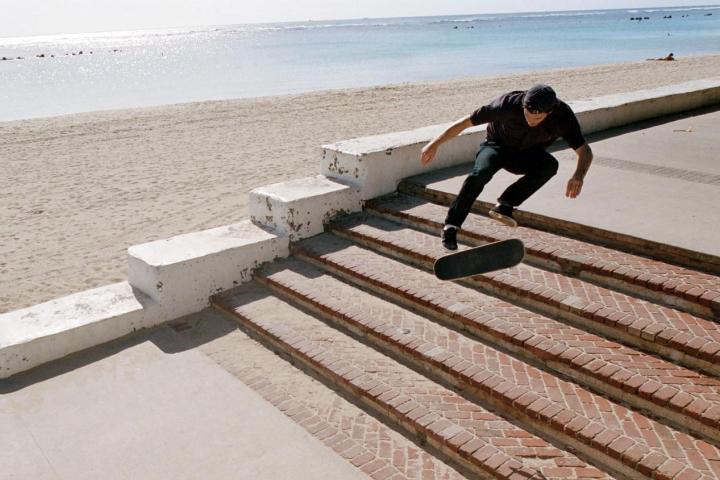
Last week, David Lokshin’s Kickstarter campaign for his new board sport-specific action tracker Trace blew past it’s funding goal, ultimately closing out at $161,260 on an initial ask of $150,000. He’s completely sold out the pre-production run of 300 Traces at $99 each. That means surfers, skateboarders, snowboarders and skiers are a lot closer to having communities of data-obsessed peers popping up around them in the same way runners and cyclists have been bombarded by Strava.
Trace is a Reece’s Peanut Butter Cup-sized technology puck that attaches to a skateboard, surfboard or snowboard and keeps an exact digital record of the board’s movement through time and space. It’s armed with an inertia sensor, built-in GPS, and Bluetooth 4.0, so it can communicate all the details of a wave, snowboard run, or skate session to an iPhone or Android phone and the rest of the world through social channels.
It can tell when a trick is attempted, how high off the ground or water it was, whether it was completed successfully and even – as Lokshin gathers more data – what the trick was.
Unlike Strava and its ilk, Trace tracks more than speed and distance. Because the device mounts an inertia sensor directly on a board, it can tell when a trick is attempted, how high off the ground or water it was, whether it was completed successfully and even – as Lokshin gathers more data – what the trick was.
Lokshin explains: “Inside of Trace there is a nine-axis inertia sensor that can very accurately tell us what your board is doing,” he says. “We then look at the sensor data and map what tricks are what. We look for the patterns, we then segregate all the information and move through each data sample. At every level we segregate more and more detail data.”
In surfing, this has the potential to change the competitive game rather dramatically. Surfing competition has always been subjectively judged by a panel of experts. Over the years, different organizations have tried to objectively quantify surfer’s performances, but aside from counting and timing the waves ridden by competitors during heats, there wasn’t much hard data that could be analyzed. With Trace, every wave can be logged and analyzed for max speed, average speed, length of wave in both time and distance, air time, and how tight the surfer’s turns were. All the judges would have to do is give the surfers style points and near-objective judging could be a reality.
For snowboarders, Trace will keep track of all kinds of data in addition to the speed, tricks, and distance. It will also count runs, chairlifts ridden, and where your friends are riding on any given day.
Skateboarders using trace will come ever-closer to turning their sessions into a game of Tony Hawk Pro Skater, as they’ll have the ability to track every trick landed on every feature at their favorite park or spot. And because all the skater’s (or snowboarder’s or surfer’s) data will be logged on the Trace app and website and can be easily shared, it could bring the concept of “gamification” to new levels for board sports participants.
Trace sounds considerably more promising than some of the action trackers we’ve seen lately (looking at you, Lit Action Tracker), and it’s chances of a successful production run may be better, too. In addition to the successful Kickstarter campaign, this isn’t Lokshin’s first rodeo flip. His business partner is his father, Anatole Lokshin, who happens to be the former CTO at Magellan Navigation and the two have already released an app for snowboarders and skiers called AlpineReplay, which they launched during the winter of 2011/12.

“AlpineReplay started as a side project,” Lokshin says. “It was kind of built out of jealousy, actually. Runners and bikers have all of these measurable metrics but there was never anything like that for action sports. We started working nights and had friends testing it. In the two seasons since we’ve gotten more than a quarter of a million users logging more than a billion vertical, 2.5 million jumps, and 380 hours of airtime.”
While somewhat sport-specific, AlpineReplay isn’t all that different from a host of GPS-enabled fitness apps. Trace, with its enhanced motion-sensing capabilities and ever-growing data library of trick recognition, may seriously shake up the action sports space in a way similar to how GoPro did just a few years ago with their POV cameras. That’s Lokshin’s hope, anyway.
“When we started [AlpineReplay] everyone kept telling us that skiers and snowboarders don’t want this info,” Lokshin says. “But once you have it you can’t live without it.”
If Trace can deliver on its potential, we’re already feeling left out by not being able to run a Trace right now. Because, as they say on Strava: if it wasn’t tracked it didn’t happen.
(Image credit Transworld Skateboarding)


